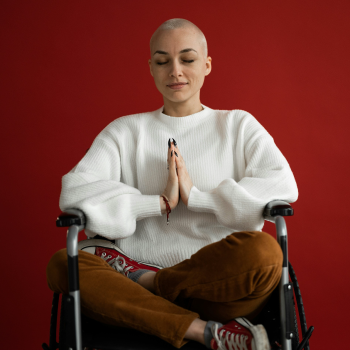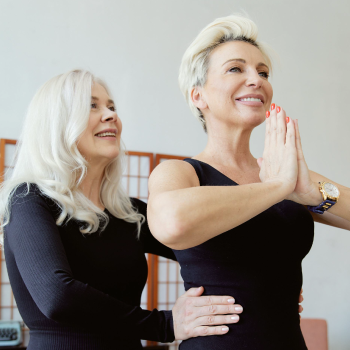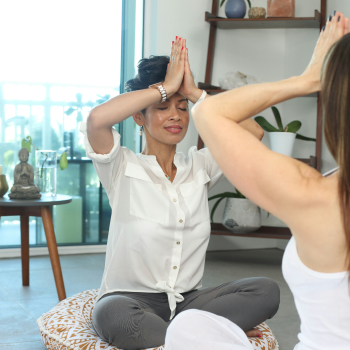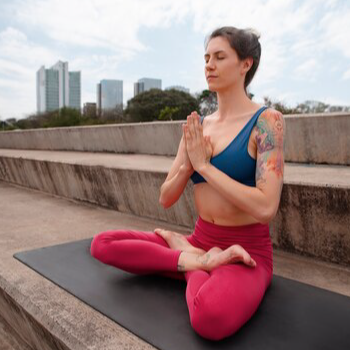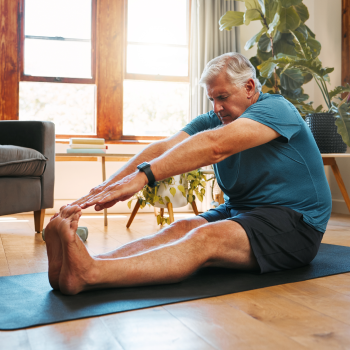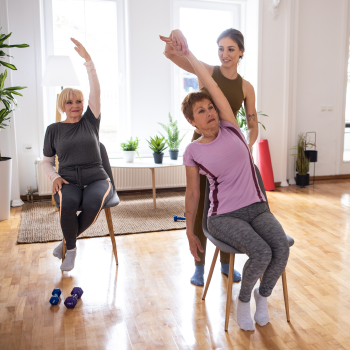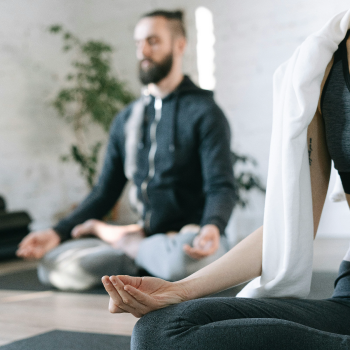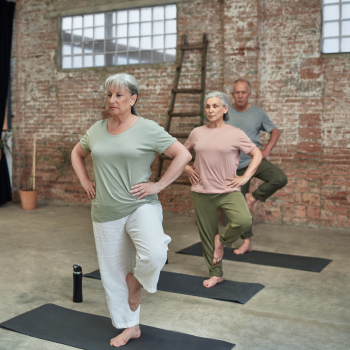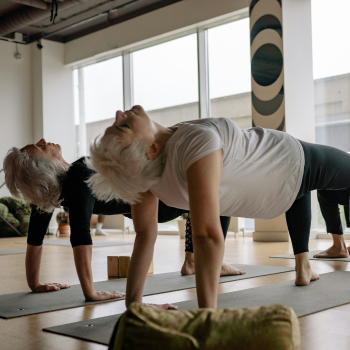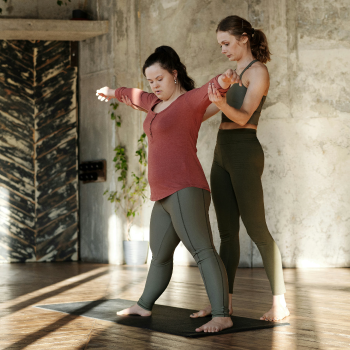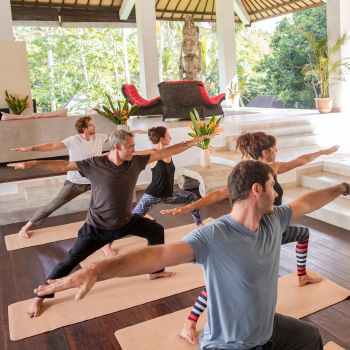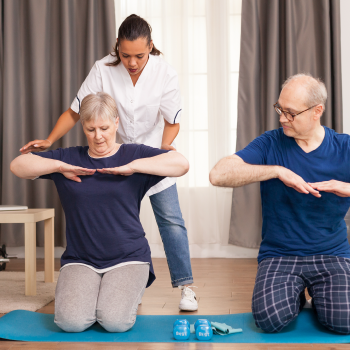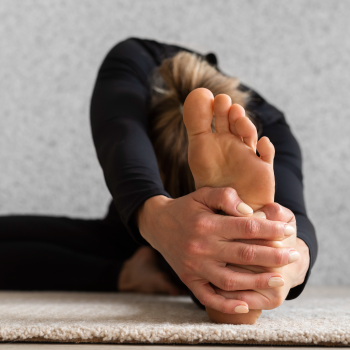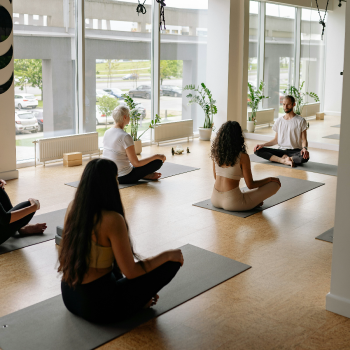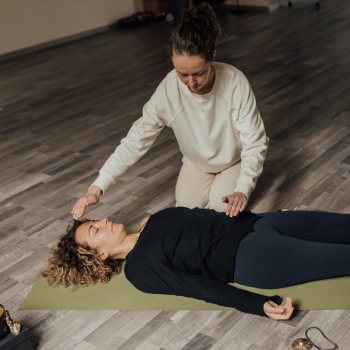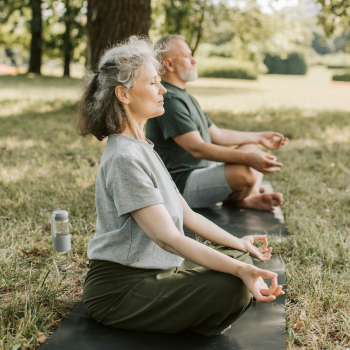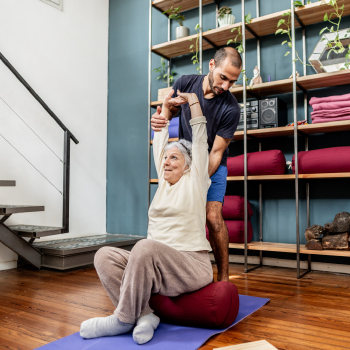Yoga as a Complementary Therapy for Children and Adolescents: A Case Study
Authors:
Lisa C. Kaley-Isley, PhD, RYT-500
John Peterson, MD
Colleen Fischer, PhD
Emily Peterson, CYT
Affiliations:
Dr. Kaley-Isley is from the University of Colorado School of Medicine, Division of Psychiatry, Denver, Colorado.
Dr. Peterson is Director, Child and Adolescent Psychiatric Services, Denver Health Medical Center and Associate Professor, Department of Psychiatry, University of Colorado School of Medicine, Denver, Colorado.
Dr. Fischer is from Denver Health Medical Center and the University of Colorado School of Medicine, Division of Psychiatry, Denver, Colorado.
Ms. Peterson is from Beloit College, Beloit, Wisconsin.
Correspondence to: Lisa C. Kaley-Isley, PhD, RYT-500 University of Colorado School of Medicine, Division of Psychiatry 9 Glenluce Road, London, UK SE3 7SD E-mail: lckaley_isley@me.com
Case Study: Jeremy was a 12-year-old boy with a history of being diagnosed with mild asthma, attention deficit hyperactivity disorder (ADHD), and recent onset obesity. Jeremy was accompanied to a psychiatric evaluation by his mother and his 14-year-old sister, Janice. The mother reported that Janice was "always stressed out" and "worried about gaining weight." The mother explained that she was interested in getting help for her children but she wished to avoid medication. She and her children heard that yoga could be helpful but they did not know much about it and wanted to learn more.
Introduction: The practice of yoga for fitness and wellness in gyms, community centers, and yoga studios is broadening into yoga therapy being provided in schools, hospitals, and community treatment centers. In fact, the leading yoga magazine, Yoga Journal, recently claimed that "yoga as medicine represents the next great wave." According to a 2008 survey, an estimated 6.9 percent (15.8 million) people in the United States practice yoga. Additionally, another 4.1 percent (9.4 million) of those who are not currently practicing yoga said they would definitely try yoga during the next year. While many clinicians remain unfamiliar with the practice of yoga, the same 2008 survey indicated that 6.1 percent (14 million) of Americans said a doctor or therapist had recommended yoga to them. Other surveys assessing the familiarity and acceptance of complementary and alternative medicine (CAM) practices by the general public and medical practitioners report similar use and acceptance patterns for yoga.
The popularity of yoga has created a need for empirical studies to evaluate the efficacy and limitations of yoga as a method of wellness, disease prevention, and treatment intervention. There is also a need to provide clinicians with practical information about yoga and the current state of evidence supporting its use with children and adolescents. The majority of available yoga studies have been conducted with adults, with recent epidemiological research indicating that many adults perceive yoga to be beneficial for musculoskeletal problems, mental health conditions, and overall health. However, studies to evaluate the potential benefits of yoga with children and adolescents are limited.
Conclusion: Yoga therapy can be a valuable complementary therapy for children and adolescents, both for preventive and therapeutic purposes. It offers a holistic approach to improving physical and mental well-being, and there is growing evidence of its effectiveness in various contexts. However, more research is needed to better understand its specific benefits and limitations for young individuals. Clinicians can play a crucial role in recommending and guiding appropriate yoga practices for their patients, as well as ensuring that these practices are safe and tailored to individual needs.
Yoga as a Therapeutic Intervention for Pediatric Mental Health
Background: Yoga has gained attention as a potential therapeutic tool for improving the mental well-being of children and adolescents. This case study explores the use of yoga as an intervention for pediatric mental health disorders, including attention deficit hyperactivity disorder (ADHD) and anxiety.
Case 1: Jeremy - ADHD and Yoga Jeremy, an 11-year-old boy, expressed interest in yoga as a means to address his symptoms of ADHD. He struggled with inattention, impulsivity, and restlessness. His clinician discussed the potential benefits of yoga for children with ADHD based on available evidence.
Therapeutic Uses of Yoga for ADHD: Several studies have explored the use of yoga as a complementary treatment for children with ADHD. Notable findings include:
A randomized controlled crossover study involving 19 boys aged 8-13 with ADHD demonstrated significant improvements in various ADHD-related symptoms, such as impulsivity and emotional lability, following a 20-week yoga program. The yoga classes included postures, breathing practices, relaxation training, and concentration exercises.
Another study involving children with ADHD (ages 8-12) found that a three-week Sahaja Yoga Meditation intervention led to a decrease in ADHD symptoms, reduced medication dosage, and improved parent-child relationship quality.
In an eight-week yoga program for Iranian children (ages 9-12) with ADHD, participants experienced a reduction in both attentional and hyperactivity symptoms.
A study involving elementary school children (ages 6-9) with attentional concerns showed that practicing yoga using a video twice a week for three weeks led to significant improvements in on-task behavior.
Case 2: Janice - Anxiety and Stress Reduction through Yoga Janice, a 14-year-old girl, was dealing with excessive stress and anxiety. She expressed interest in yoga as a potential way to alleviate her symptoms. Her clinician discussed the potential benefits of yoga for managing anxiety.
Therapeutic Uses of Yoga for Anxiety: Several studies have explored the use of yoga as a treatment for anxiety in children and adolescents:
An intervention combining yoga postures, rolling pin massage, and progressive muscle relaxation was used with 40 psychiatrically hospitalized adolescents diagnosed with adjustment disorder and depression. The combination intervention showed immediate positive effects on anxiety symptoms.
While research specific to yoga for anxiety in children is limited, the broader body of evidence suggests that yoga can be an effective tool for reducing stress and anxiety in adults. These findings suggest that it may have similar benefits for adolescents like Janice.
Conclusion: Yoga shows promise as a therapeutic intervention for pediatric mental health disorders, including ADHD and anxiety. However, it is important for children to be thoroughly evaluated by healthcare professionals before starting yoga as a treatment. Additionally, the available studies often have small sample sizes and limitations, highlighting the need for further research to establish the effectiveness of yoga in pediatric mental health care. Ultimately, yoga can be considered as a complementary approach to traditional treatments, potentially offering benefits in terms of symptom management and overall well-being.
The Therapeutic Potential of Yoga for Children and Adolescents
Introduction: Jeremy, an 11-year-old boy, was diagnosed with ADHD, while Janice, a 14-year-old girl, was recently diagnosed with irritable bowel syndrome (IBS). Both of them were interested in exploring yoga as a complementary therapy to manage their respective health concerns. The clinician discussed the potential benefits of yoga for pediatric mental health and medical disorders based on available research evidence.
Methods: The clinician reviewed studies that explored the therapeutic uses of yoga for children and adolescents with various mental health and medical conditions. These studies assessed the effects of yoga on conditions such as anxiety, attention deficit hyperactivity disorder (ADHD), depression, eating disorders, asthma, and irritable bowel syndrome (IBS).
Findings:
ADHD: Several studies evaluated the effects of yoga on children diagnosed with ADHD. In a controlled crossover trial, yoga was found to significantly improve various ADHD-related symptoms, including oppositional behavior, emotional lability, and impulsivity. The positive effects were more pronounced in children who practiced yoga more frequently. Another study with ADHD-diagnosed children reported significant reductions in ADHD symptoms after an eight-week yoga program.
Anxiety: Three studies investigated the impact of yoga on anxiety in children and adolescents. One study combined yoga postures, massage, and progressive muscle relaxation, resulting in decreased anxiety and increased positive affect among hospitalized adolescents. A "Training of Relaxation with Elements of Yoga for Children" program also led to reduced aggression, helplessness in school, physical complaints, and improved stress-coping abilities. However, it did not significantly reduce school exam anxiety or increase self-efficacy. A study with college students found that Hatha yoga significantly reduced perceived stress and negative affect.
Eating Disorders: Three studies examined the potential benefits of yoga for children and adolescents with eating disorders. An eight-week yoga program, when added to standard outpatient treatment, resulted in greater decreases in eating disorder symptoms and reduced food preoccupation. A study with normal fifth-grade girls found significant decreases in body dissatisfaction and improved social self-concept. However, no significant differences were observed in drive for thinness, eating disordered attitudes/intentions, or perceived stress.
Asthma: Two studies explored the effects of yoga on children with asthma. Both studies showed improvements in pulmonary functions and exercise capacity following yoga practice, along with decreased exercise-induced bronchoconstriction. These benefits were sustained over an extended follow-up period.
Irritable Bowel Syndrome (IBS): A study involving adolescents with IBS found that a 14-minute yoga video led to lower levels of functional disability, reduced use of emotion-focused avoidance, and decreased anxiety levels compared to a control group.
Diabetes: An uncontrolled pilot study reported positive outcomes, including weight loss, improved self-concept, and reduced anxiety symptoms, in predominantly Hispanic children at risk for type 2 diabetes following a 12-week modified Ashtanga yoga program.
Discussion: The case study highlights the potential therapeutic benefits of yoga for children and adolescents with various mental health and medical conditions. Yoga appears to offer advantages such as non-pharmacological intervention, minimal adverse effects, and accessibility. However, the outcomes can vary based on the condition and the specific type and intensity of the yoga program. Further research is needed to explore the optimal duration and frequency of yoga interventions and to gather more systematic data on potential adverse effects.
Conclusion: Both Jeremy and Janice decided to incorporate yoga into their healthcare routines. They experienced positive effects from practicing yoga, including reduced symptoms and improved well-being. Their mother also joined in the practice, recognizing the health-promoting aspects of yoga. Yoga continues to be a promising complementary therapy for pediatric mental health and medical conditions, but further research is needed to refine its application and measure its long-term effects.
Exploring the Potential of Yoga for Children and Adolescents
Introduction: This case study delves into the therapeutic potential of yoga for children and adolescents facing various mental health and medical challenges. It highlights the promising findings from existing research while acknowledging the need for more systematic and comprehensive studies in this domain. Additionally, it underscores the importance of considering precautions and potential risks associated with yoga practice, especially among vulnerable populations.
Methods: The review encompasses studies investigating the effectiveness of yoga as a complementary intervention for school-age children and adolescents. It examines the impact of yoga on conditions such as ADHD, anxiety, eating disorders, asthma, and irritable bowel syndrome (IBS). The case study recognizes the limitations of the existing literature, which often lacks randomized controlled trials, adequate sample sizes, and standardized outcome measures.
Findings:
Precautions and Risks: The case study underscores the importance of adhering to precautions when practicing yoga, particularly for individuals with specific medical conditions (e.g., high or low blood pressure, glaucoma, pregnancy). It highlights the need for trimester-specific guidance for pregnant women engaging in yoga. Adverse effects of yoga, though generally rare, should be systematically documented in future studies.
ADHD: Multiple studies suggest that yoga may be beneficial for children with ADHD. It has been associated with improvements in behavior, impulsivity, and emotional regulation. However, further research is needed to confirm these findings with larger sample sizes and randomized controlled trials.
Anxiety: Yoga appears to have a positive impact on anxiety reduction among children and adolescents. Studies have reported decreased anxiety levels, increased positive affect, and improved stress coping abilities. However, the varying results indicate the need for more comprehensive research to understand the specific conditions under which yoga is most effective.
Eating Disorders: Research shows promising results for the use of yoga in addressing eating disorders in youth. It has been associated with reduced food preoccupation, lower levels of anxiety and depression, and improved self-concept. However, more extensive studies are necessary to establish its effectiveness.
Asthma: Yoga interventions have demonstrated improvements in pulmonary functions, exercise capacity, and exercise-induced bronchoconstriction among children with asthma. The long-term effects and optimal dosage require further exploration.
Irritable Bowel Syndrome (IBS): A short yoga video has shown potential benefits for adolescents with IBS, leading to lower levels of functional disability, reduced emotion-focused avoidance, and decreased anxiety. However, additional research is needed to validate these findings.
Discussion: This case study emphasizes the need for more systematic research on yoga as an intervention for children and adolescents. Long-term studies, larger sample sizes, and rigorous control groups are essential to establish evidence-based practice recommendations. Standardization of outcome measures and the exploration of underlying processes contributing to yoga's benefits are areas warranting further investigation.
Conclusion: While the existing research shows promise, yoga's therapeutic potential for children and adolescents remains underexplored. This case study highlights the need for cautious implementation of yoga, considering individual health conditions and potential risks. It also underscores the importance of conducting comprehensive studies to better understand the specific conditions and populations for which yoga may offer the most significant benefits.
References:
White, Laura Santangelo. "Yoga for children." Pediatric nursing 35.5 (2009): 277.
Kaley-Isley, Lisa C., et al. "Yoga as a complementary therapy for children and adolescents: a guide for clinicians." Psychiatry (Edgmont) 7.8 (2010): 20.
Chimiklis, A.L., Dahl, V., Spears, A.P. et al. Yoga, Mindfulness, and Meditation Interventions for Youth with ADHD: Systematic Review and Meta-Analysis. J Child Fam Stud 27, 3155–3168 (2018). https://doi.org/10.1007/s10826-018-1148-7
Li, Amber W., and Carroll-Ann W. Goldsmith. "The effects of yoga on anxiety and stress." Alternative Medicine Review 17.1 (2012).
Written By: Ram on 06-01-2023

